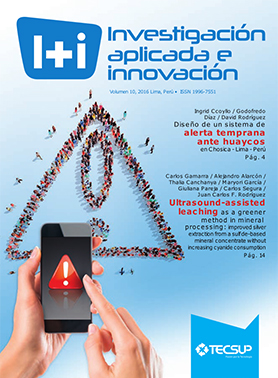Lixiviación asistida con ultrasonido como método de mayor ecoeficiencia en el procesamiento de minerales: extracción mejorada de plata de un concentrado basado en sulfuros sin consumir más cianuro
DOI:
https://doi.org/10.71701/x4fw7652Keywords:
Leaching, ultrasound, sonication, silver, cyanideAbstract
Improving the efficiency of noble metal extraction without increasing the consumption of the leaching agent is one of the goals in the development of novel hydrometallurgical routes. This is particularly important when dangerous compounds (such as cyanide) are involved in mineral processing. Ultrasound-assisted leaching is presented here as an advantageous process able to increase the amount of silver leached from a polymetallic sulfide-based mineral by ~300%, without increasing cyanide consumption. Our results suggest that sonication removes solid by-products that hinder the leaching process. While in the absence of sonication cyanide consumption rises steadily even though silver leaching has reached a maximum, under sonication both cyanide consumption and silver extraction follow similar trends, indicating that side reactions are decreased. The enhanced efficiency in both silver extraction and cyanide consumption indicate that ultrasound-assisted leaching can be introduced as a greener method in mineral processing.
Downloads
References
Aylmore, M. G. , & Muir, D. M. (2001). Thiosulfate leaching of gold - A review. Minerals Engineering, 14 (2), 135–174.
La Brooy, S. R. , Linge, H. G. , & Walker, G. S. (1994). Review of gold extraction from ores. Minerals Engineering, 7 (10), 1213–1241.
Habashi, F. (2012). A review. Pollution Problems of the Metallurgical Industry. Revista del Instituto de Investigación de la Facultad de Geología, Minas, Metalurgia y Ciencias Geográficas, 15 (29), 49–60.
Dzombak, D. A, Gosh, R. S., & Wong-Chong, G. M. (2006). Cyanide in water and soil: Chemistry, risk and management. Florida: Taylor and Francis Group.
Wadsworth, M. E. (2000) Surface processes in silver and gold cyanidation. International Journal of Mineral Processing, 58 (1–4), 351–368.
Senanayake, G. (2008). A review of effects of silver, lead, sulfide and carbonaceous matter on gold cyanidation and mechanistic interpretation.Hydrometallurgy,90 (1), 46–73.
Karimi, P., Abdollahi, H., Amini, A., Noaparast, M., Shafaei, S. Z., & Habashi, F. (2010). Cyanidation of gold ores containing copper, silver, lead, arsenic and antimony. International Journal of Mineral Processing, 95 (1–4), 68–77.
Feng, D., & Van, J.S.J. (2010) Thiosulphate leaching of gold in the presence of ethylenediaminetetraacetic acid (EDTA). Minerals Engineering, 23 (2), 143–150.
Senanayake, G. (2004). Gold leaching in non-cyanide lixiviant systems: critical issues on fundamentals and applications. Minerals Engineering, 17(6), 785–801.
Ha, V. H., Lee, J. , Jeong, J., Hai, H. T., & Jha, M. K. Thiosulfate leaching of gold from waste mobile phones. Journal of Hazardous Materials, 178 (1–3), 1115–1119.
Alfaro, E. , & Michel, D. (2010). Lixiviación de minerales de oro con el uso de tiosulfato: tecnología alterna a la cianuración de minerales de oro. Revista del Instituto de Investigación de la Facultad de Geología, Minas, Metalurgia y Ciencias Geográficas, 13 (26), 67-72.
Azareño, A., Aramburú, V., Quiñones, J., Puente, L., Cabrera, M., Falconi, V., Quispe, J., Cardoza, O., Jaimes, K., & Medina, A. (2010). Tratamiento Hidrometalurgico del oro diseminado en pirita y arsenopirita del relave de flotación. Revista del Instituto de Investigación de la Facultad de Geología, Minas, Metalurgia y Ciencias Geográficas, 13 (25), 7-12.
Bolorunduro, S. A., Dreisinger, D. B., & Van, G. (2003). Zinc and silver recoveries from zinc–lead–iron complex sulphides by pressure oxidation. Minerals Engineering, 16 (4), 375–389.
Duoqiang, L., Jikun, W., Yunhua, W., Jibo, J., & Fan, W. (2008). Recovery of silver and zinc by acid pressure oxidative leaching of silver-bearing low-grade complex sulfide ores. International Journal of Mineral Processing, 89 (1–4), 60–64.
Akcil, A., & Ciftci, H. (2003). Metals recovery from multimetal sulphide concentrates (CuFeS2 –PbS–ZnS): combination of thermal process and pressure leaching. International Journal of Mineral Processing, 71 (1–4), 233–246.
Al-Harahsheh, M., & Kingman, S. W. (2004). Microwave-assisted leaching—a review. Hydrometallurgy, 73 (3–4), 189-203.
Öncel, M. S., Ince, M. & Bayramoglu, M. (2005). Leaching of silver from solid waste using ultrasound assisted thiourea method. Ultrasonics Sonochemistry, 12 (3), 237–242.
Wang, X., Srinivasakannan, C., Duan, X. H., Peng, J. H., Yang, D. J., & Ju, S. H. (2013). Leaching kinetics of zinc residues augmented with ultrasound. Separation and Purification Technology, 115, 66–72.
Tian, Q.H., Jiao, C.Y., & Guo, X.Y. (2012). Extraction of valuable metals from manganese–silver ore. Hydrometallurgy, 19-120, 8-15.
Mason, T. J., & Lorimer, J. P. (2002). Applied Sonochemistry: Uses of power ultrasound in chemistry and processing. Weinheim: Wiley-VCH.
Luque-García, J. L., & Luque de Castro, M. D. (2003). Ultrasound: A powerful tool for leaching. TrAC Trends in Analytical Chemistry, 22 (1), 41–47.
Collasiol, A., Pozebon, D., & Maia, S. M. (2004). Ultrasound assisted mercury extraction from soil and sediment. Analytica Chimica Acta, 518 (1–2),157–164.
Jeffrey, M. I., & Breuer, P. L. (2000).The cyanide leaching of gold in solutions containing sulfide. Minerals Engineering, 13 (10-11), 1097–1106.
Downloads
Published
Issue
Section
License

This work is licensed under a Creative Commons Attribution-NonCommercial 4.0 International License.


